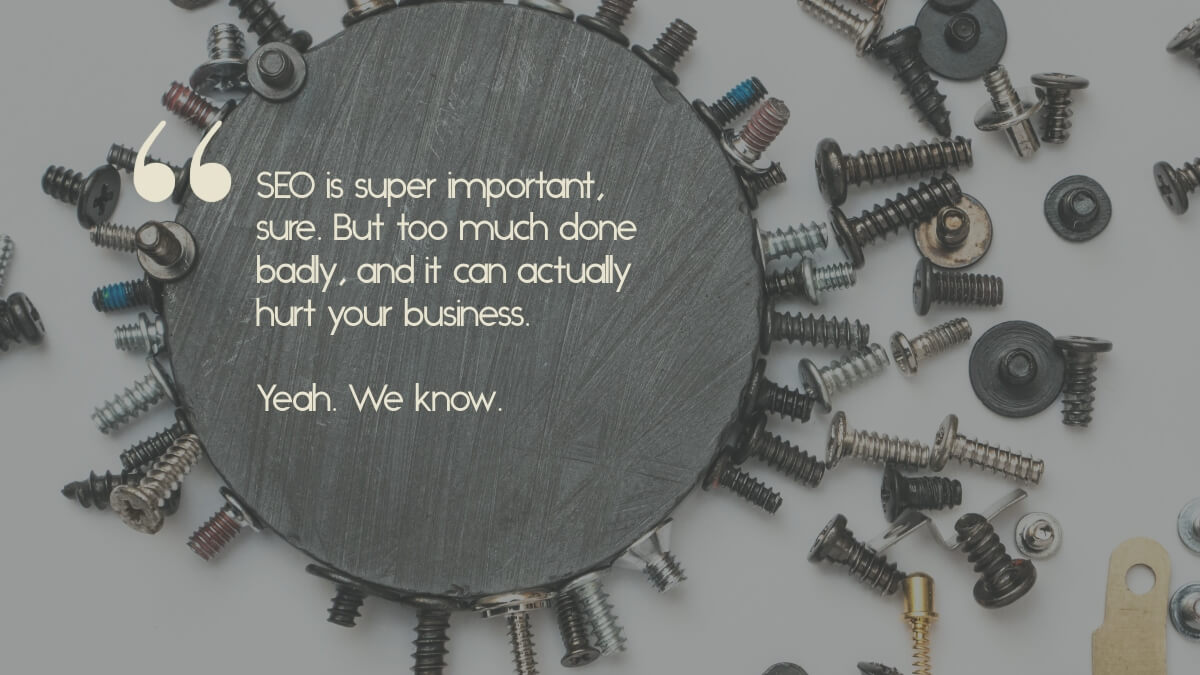Unintentional SEO: when search engine optimization hurts rather than helps

Every once in a while we’ll get fired up about our SEO (Search Engine Optimization) and go on a tear, doing all the things that we think are critical: optimizing tags on our site, making sure images have alt-text, etc. etc. etc. (a lot of which is largely useless anymore, but that’s another story).
The problem is that in our frenzy we often ignore the truly critical element of modern SEO—namely, good, human-readable content—and its impact on our site’s rankings and user experience. We’ve written about that before, and so won’t spend a ton of time going over the importance of content to your SEO strategy.
More importantly (and often entirely overlooked) we often ignore what pages on our site are ranking on Google and Bing, and hence being delivered to our visitors. Sometimes we focus a little too much on our page rankings in the SERPs (Search Engine Results Pages), to the detriment of our visitors’ experience on our sites.
Said differently, it’s not enough to rank #1 for a given keyword. If we’re not paying attention, it’s entirely possible to end up in a scenario where a truly suboptimal page takes over our organic rankings, leading to a poor user experience and, ultimately, bad conversion rates.
Recently, we came across a perfect example of this issue. One of our clients had an article posted about their business in a major publication. The client’s’ previous marketing company copy-and-pasted the story, in full, to a new page on our client’s site. They helpfully provided a ton of useful backlinks as well. Over time, that page continued to amass authority with Google, to the point where it became the #1 landing page on our client’s site, accounting for close to a third of their organic traffic, eclipsing the pages that dealt more with our client’s core business.
Unfortunately, while it accounted for about a third of the organic traffic to the site overall, it also had a 95% bounce rate (meaning people came to that page, looked, and left). So, while the aim of the previous marketing firm in posting the article for our client was good, the outcome was not. It was vacuuming up traffic without converting them to customers.
Unintentional SEO and what you can do about it
I’m going to go out on a limb and create a new acronym for this: USSR (Unintentional Suboptimal Search Reality).
Here are a few of the common mistakes we’re all guilty of making with our website pages that can lead to Unintentional Suboptimal Search Reality:
- Way too much copy. Yes, search bots may read it all, but we’ve seen instances where this leads to a page taking over your results and pushing down other pages that are more likely to convert visitors into customers if they had landed there first.
- Way too many topics. A good landing page is generally pretty focused on one or two concepts. If your landing page meanders all over the place, covering a multitude of subjects, it may end up ranking well for multiple keywords in the SERPs, but it may also make your visitors throw up their hands in frustration.
- No obvious CTA (Call To Action). If your landing pages don’t have an obvious CTA that’s relevant to the term(s) for which you’re trying to optimize, then your visitors will likely be confused and/or too bored to continue.
Checking for Unintentional SEO on your website
How can you find if you have USSRs lurking on your site? One place to start is by taking a look at Google Analytics and specifically looking at behavior on your most popular, highly visited pages.
- If those pages have unusually high bounce rates, you may want to take a look and make sure you’re not overwhelming your visitors and making them wade through a ton of copy, or hiding your CTA way below the fold, etc.*
- If people are spending a lower amount of time on your landing pages than the overall average time spent on your site, it’s a good sign that they’re not easily able to digest the contents of the page and are abandoning it for greener pastures.
- Take a look at your visitors’ behavior after they’ve hit a given landing page. Ask yourself the simple question – “Are they doing what I want them to do once they’ve hit that page?” In other words, if your goal is to have them move on to filling in a contact form or buying a product, are they converting? And if so, is it happening at an acceptable rate, or could it be higher?
- When building new pages, make sure you’re keeping them tight and to the point, with clear CTAs. Ask yourself if they would make sense to someone who landed there first.
This can be an insidious problem and often one that’s difficult to solve without taking some risks and reworking significant portions of a website. But in the long run, focusing on the user experience on your site will pay dividends. Google never rests; it’s continually looking for ways to reward sites and pages that have great user experiences.
Sooner or later, the sorts of clunky, suboptimal pages that are currently “working” will be penalized as Google updates its algorithm.
Start today and break down your own personal USSR. In the words of one of our past presidents, “Tear down this wall Mr. Gorbachev, tear down this wall!”
Happy small business marketing!
Theron & Katie
*Note: if you have a content marketing program, you will naturally see some blogs that rank high and have high bounce rates, and that’s OK—and the last thing you want to do with content is litter it with CTAs. Fight USSR in this case by including pop-ups on content pages that collect email subscriptions before people leave the page, and make sure that your content is super relevant to your industry and what you do.
At Urban Sherpa Marketing Co. we offer marketing advisory, strategic planning, and services for small businesses and startups, including content marketing. Our goal is to make high-quality marketing possible for every business, no matter the size. Think of us as your outsourced marketing department, strategic marketing advisor, or even your phone-a-friend marketing lifeline. We specialize in building efficient marketing programs to grow your business without blowing the bank.
Share this on:

